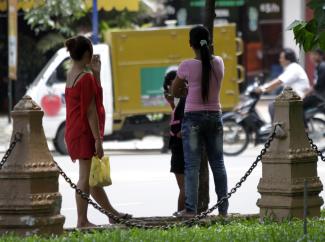Sex tourism
Dubious reputation

The latest trend seems to be sexual abuse of children in Cambodian orphanages. Male perpetrators, in the guise of tourists or volunteers, get easy access to underage girls and boys. Several cases of this sort were uncovered in the past years. The UN Committee on the Rights of the Child (CRC) stated in a report released in February it was concerned about “orphanage tourism, which seems to be a growing phenomenon where children in institutions and orphanages are being exposed to sexual exploitation by foreigners” in Cambodia (see box).
Cambodia has long been a destination for male sex tourists from Asia and western countries. Prostitution, although prohibited by law, is rampant all over the country and especially visible at the touristic hotspots. Whether in Siem Reap, the gateway to the famous temples of Angkor, in the capital Phnom Penh or the resort town of Sihanoukville, girls are readily available. They work in karaoke bars, massage salons and on the streets.
The newspaper Cambodia Daily quoted tourism minister Thong Khon as saying that there are 659 adult entertainment venues across the country employing more than 11,000 workers. Not all of them are sex workers, of course. More than one in four establishments are unlicensed, according to the report, so the government does not regulate them. The statistics do not inspire confidence.
Most prostitutes come from the poor Cambodian countryside, but some are from neighbouring countries like Vietnam. Prostitution in Cambodia is cheap. It is said that women sell themselves for as little as five dollars. Western tourists, though, are more likely to pay at least $ 20 to $ 30. The prices are considerably lower than in Thailand, Cambodia’s neighbour and one of the world’s most notorious sex tourism destinations. Cheap and easy access to prostitutes is one of the reasons why the industry is on the rise in Cambodia. “While the majority of those who pay for sex in Cambodia are Cambodians”, the country’s sex tourism industry is expanding, the UN Office of Drugs and Crime (UNODC) pointed out in a study on transnational organised crime in east Asia and the Pacific in 2013.
One in three prostitutes is under 18
Both sex tourists and local men demand underage girls and boys. According to the US State Department’s Trafficking in Persons Report 2014, “Cambodian men form the largest source of demand for child prostitution; however, men from other Asian countries, the United States, and Europe travel to Cambodia to engage in child sex tourism“.
The UN’s children’s rights committee estimates that one third of prostitutes in Cambodia is under 18 years old. Human trafficking is a big problem. UNICEF states that some 37 % of the victims trafficked for sexual exploitation in Cambodia are children. The US State Department, however, reports that some children engage in prostitution without third party involvement. They are driven by the need to survive.
The country has the dubious reputation of being a heaven for paedophiles. It is enough to ask a tuk tuk driver, guest house owner or waiter for a little girl or boy. Even some desperate parents sell their daughters’ virginity. The State Department authors acknowledge: “The sale of virgin women and girls continues to be a problem in Cambodia.“
Cambodia’s Trafficking in Persons Law provides penalties ranging from two to 15 years in prison for commercial sexual exploitation of children. The law also prohibits child pornography. However, non-governmental organisations (NGOs) bemoan weak law enforcement and rampant corruption. Activists say that the police and other government agencies benefit from the illicit business they are supposed to eradicate.
The situation has been improving over the years. Nowadays trials take place and convictions occur. National and international media report such cases. According to data compiled by Action Pour Les Enfants (APLE), a Cambodian NGO, 115 foreigners were convicted of child sex crimes between 2003 and 2014.
A recent case concerned a British man who was sentenced to seven years in prison in February. He was found guilty of sexually abusing four boys under 15 at a café he owned in the city of Battambang. When this essay was finalised in early March, ongoing trials concerned a British tourist accused of sexually abusing four girls between the ages of seven and 11 in Phnom Penh and an American teacher at a private school in the capital. He is accused of abusing four impoverished Cambodian boys aged between five and 11.
Last year, the Labour Ministry announced new regulations aimed at protecting sex workers and other staff at entertainment venues. According to Cambodia Daily, Minister Ith Sam Heng has promised new rules that will cover working conditions, safety, health and access to HIV services. The paper quoted the minister saying that employees in the “thriving” sector were to get legal protection for the first time. Initially, adherence to the regulations will be voluntary. However, the government plans to introduce fines, the newspaper reported.
More boy victims than girls
Many of the children in the sex business are street children and thus vulnerable in all respects. Several local NGOs offer support. APLE has been working since 2003 “to protect children, identify and counter the sexual abuse and exploitation of children with a focus on traveling sex offenders”, according to its website. The organisation has established a hotline that allows anybody to report abuse anonymously. It also gives social and legal aid to victims and raises public awareness for the issue.
APLE reports that it deals with more boy victims than girls. The reason is that this agency focuses on street-based exploitation, which mostly affects boys. Foreign sex offenders actively look for boys, according to APLE. Girls, on the other hand, are said to be more likely to become “victims of establishment-based abuse and situational offenders”.
The civil-society network ECPAT Cambodia (End Child Prostitution, Abuse and Trafficking in Cambodia) unites 26 NGOs and was established in 1995. ECPAT regularly conducts workshops to raise awareness of sexual exploitation of children in the tourism industry. The latest event, organised in January in cooperation with the Ministry of Tourism, was attended by representatives of 28 private-sector companies from the tourism sector. ECPAT encourages hotels and other operators in the sector to establish a code of conduct to protect children.
Most Cambodians are deeply ashamed of their country’s image as a sex tourism destination. That will only change, however, if all sides work together.
Katja Dombrowski is a member of the D+C/E+Z’s editorial team. She lived in Cambodia from 2004 to 2007.
euz.editor@fs-medien.de
Links:
UNODC: Transnational organized crime in East Asia and the Pacific.
http://www.unodc.org/documents/data-and-analysis/Studies/TOCTA_EAP_web.pdf
U.S. Department of State: Trafficking in Persons Report 2014.
http://www.state.gov/j/tip/rls/tiprpt/2014/?utm_source=NEW+RESOURCE:+Trafficking+in+Persons+R








